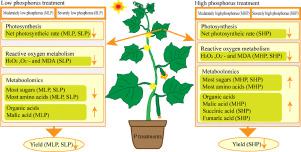Scientia Horticulturae ( IF 3.9 ) Pub Date : 2022-04-26 , DOI: 10.1016/j.scienta.2022.111156 Shuang Wang 1, 2, 3, 4 , Shiwei Zheng 1, 2, 3, 4 , Ting Bian 1, 2, 3, 4 , Tong Wu 1, 2, 3, 4 , Xiaoxia Li 1, 2, 3, 4 , Hongdan Fu 1, 2, 3, 4 , Zhouping Sun 1, 2, 3, 4 , Tianlai Li 1, 2, 3, 4

|
Improper application of phosphorus fertilizer is common in vegetable production, and phosphorus stress affects cucumber growth and reduces yield. However, the underlying physiological and metabolic mechanism of cucumber yield reduction remains unclear. Therefore, photosynthetic capacity, reactive oxygen metabolism and metabolomics analyses were performed in cucumber leaves under phosphorus stress. The results showed that compared with the control (CK), moderately low phosphorus (MLP), severely low phosphorus (SLP) and severely high phosphorus (SHP) treatments significantly reduced the biomass and yield of cucumber and inhibited the photosynthetic capacity of leaves. The SLP, moderately high phosphorus (MHP) and SHP treatments all caused an overproduction of H2O2 and O2•−, resulting in significant oxidative damage. In addition, low phosphorus (LP) treatments disturbed nitrogen metabolism, and high phosphorus (HP) treatments disturbed carbon and nitrogen metabolism in cucumber leaves. Compared with CK, the content of most sugars and amino acids decreased significantly under LP treatments; this decrease intensified under SLP treatment, and the lack of nutrients seriously inhibited yield formation. In addition, the malic acid content increased in the leaves, which might be the feedback regulation method used by cucumber in response to phosphorus deficiency. Under HP treatments, most sugars, amino acids and organic acids in the leaves increased, and cucumbers accumulated compatible solutes (sugars and amino acids) to cope with the decreased soil osmotic potential, which resulted in excessive carbon and nitrogen resources being trapped in cucumber leaves rather than being allocated to yield. These results indicated that the LP and SHP treatments inhibited the photosynthetic capacity of cucumber, disturbed the reactive oxygen metabolism and physiological metabolism in the leaves, and ultimately affected cucumber yield.
中文翻译:

光合特性结合代谢组学分析揭示了不同磷胁迫诱导黄瓜(Cucumis sativus)减产的潜在机制
蔬菜生产中磷肥施用不当常见,磷胁迫影响黄瓜生长,降低产量。然而,黄瓜减产的潜在生理和代谢机制仍不清楚。因此,对磷胁迫下的黄瓜叶片进行光合能力、活性氧代谢和代谢组学分析。结果表明,与对照(CK)相比,中低磷(MLP)、重度低磷(SLP)和重度高磷(SHP)处理显着降低了黄瓜的生物量和产量,抑制了叶片的光合能力。SLP、中高磷 (MHP) 和 SHP 处理均导致 H 2 O 2和 O 2的过量产生•−,导致显着的氧化损伤。此外,低磷(LP)处理扰乱了黄瓜叶片的氮代谢,高磷(HP)处理扰乱了黄瓜叶片的碳和氮代谢。与CK相比,LP处理下大部分糖类和氨基酸含量显着降低;这种下降在 SLP 处理下加剧,而营养物质的缺乏严重抑制了产量的形成。此外,叶片中苹果酸含量增加,这可能是黄瓜对缺磷反应的反馈调节方法。在 HP 处理下,叶片中的大部分糖、氨基酸和有机酸增加,黄瓜积累了相容的溶质(糖和氨基酸)以应对土壤渗透势的降低,这导致过多的碳和氮资源被困在黄瓜叶片中,而不是分配给产量。这些结果表明,LP和SHP处理抑制了黄瓜的光合能力,扰乱了叶片的活性氧代谢和生理代谢,最终影响了黄瓜的产量。











































 京公网安备 11010802027423号
京公网安备 11010802027423号